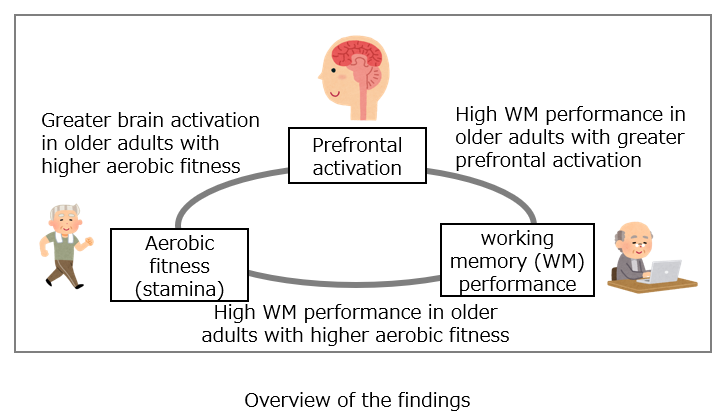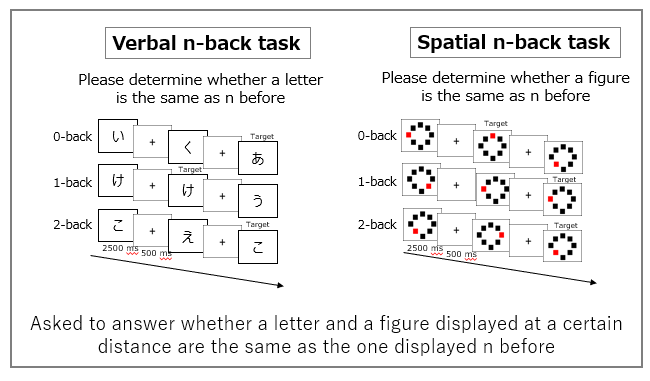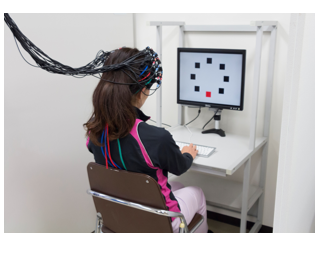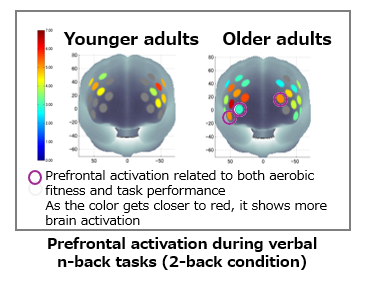2024.08.05
News
Elucidating new neural mechanisms on maintaining cognitive functions: Older adults with high aerobic fitness show superior working memory
Key points
●It is known that higher aerobic fitness1 is associated with better working memory (WM) ability2 in older adults; however, its neural mechanisms were yet to be revealed. The group studied its mechanisms using functional Near-Infrared Spectroscopy (fNIRS)3.
●During a WM task, older adults exhibited more or greater activation in the prefrontal cortex (PFC) than younger adults, especially when engaging in difficult tasks. This result indicates that aging prompts extended recruitment of the prefrontal cortex in a compensatory manner.
●It was also evident that the prefrontal cortex of older adults with higher aerobic fitness showed high compensatory activation and superior performance of WM tasks.

Abstract
The study group led by Researcher Kazuki Hyodo of Meiji Yasuda Life Foundation of Health and Welfare, Professor Ippeita Dan of Chuo University, and Professor Hideaki Soya of the Institute of Health and Sport Sciences, University of Tsukuba, examined the association between older adults’ aerobic fitness (stamina) and working memory (WM) performance which is one of the cognition functions, and their relations with prefrontal cortex activation patterns using fNIRS. They compared the participants of 1) older adults and younger adults, as well as 2) older adults of divergence between aerobic fitness. During WM task with difficult condition, older adults recruited more prefrontal region than younger adults, which indicates that older adults tackle difficult cognitive works by increasing prefrontal recruitment in a compensatory manner. Furthermore, older adults with higher aerobic fitness showed greater brain activation in a compensatory manner during cognitive tasks, which led to higher task performance. According to the aforementioned results, older adults can expect positive effects on WM performance by exercising routinely to maintain and increase aerobic fitness.
The finding of this study has been published in “Imaging Neuroscience,” an international academic journal on neuroscience, as of May 10th, 2024.
Background
WM is a part of cognitive function that temporarily stores and operates information, and the prefrontal cortex is primarily responsible for its functions. It plays a vital role in everyday activities such as conversations and calculations. However, the function is prone to aging, impacting the quality of life. Previous studies have found that aerobic exercise contributes to higher WM performance and older adults with high aerobic fitness show high performance in WM tasks. However, the functional neural mechanisms remain under debate. Previous studies on brain activity during a WM task have revealed that the prefrontal cortex of older adults activates in larger areas than younger adults and brain activation is associated with task performance. From such findings, it is considered that older adults work on maintaining cognitive function by increasing the recruitment of the prefrontal cortex. Therefore, older adults with higher aerobic fitness might show greater activation in the prefrontal cortex and have higher task performance. In this research, we used fNIRS to compare compensatory brain activation in older and younger adults during WM tasks. In addition, we have studied whether the increase in compensatory brain activation in the prefrontal cortex is associated with aerobic fitness and WM performance in older adults.
Methods
The study was conducted on 47 older adults (age range of 65 to 74, 29 female) and 49 younger adults (age range of 18 to 24, 23 female). Participants performed computer-based verbal and special n-back tasks4 in a random order. The n-back tasks consisted of three conditions: 0-back (no WM load), 1-back (low WM load), and 2-back (high WM load). The reaction time and accuracy were evaluated as task performance. During tasks, we assessed their brain activation by measuring changes in oxygenated hemoglobin and deoxygenated hemoglobin concentrations of the prefrontal cortex using fNIRS. Furthermore, we measured ventilation threshold (VT)5 just for older adult participants to assess their aerobic fitness through a graded exercise test (GXT) using an upright cycle ergometer.

An example of n-back task

During an experiment
Results
A comparison of performance and brain activation during verbal and spatial n-back tasks between older adults and younger adults revealed that older adults had lower performance (long reaction time and low accuracy) than younger adults. Moreover, older adults showed greater and larger prefrontal cortex activation than younger adults. This result confirmed that a) older adults’ WM performance is deteriorating compared to younger adults, and b) older adults show extended prefrontal cortex activation to work on challenging tasks.
Next, as we focus on the relationship between aerobic fitness, task performance, and brain activation in older adults, it was indicated that older adults with higher aerobic fitness showed more activation in brain area that was not active in younger adults during tasks, which may be associated with high task performance (reaction time under the difficult condition).

Summary
The study confirmed that older adults perform difficult WM tasks by extending the prefrontal cortex in a compensatory manner compared to younger adults, and older adults with higher aerobic fitness have greater WM performance by recruiting greater or more extensive compensatory brain activation. The finding of this study may provide insights into the functional neural mechanisms of why older adults with high aerobic fitness perform better in WM tasks. The group expects to elucidate the causal relationships by examining the relationship between exercise training-induced change in the aerobic fitness, WM ability, and brain activation in older adults.
Journal : Imaging Neuroscience
Title : Neural mechanisms of the relationship between aerobic fitness and working memory in older adults: an fNIRS study
Authors: Kazuki Hyodo, Ippeita Dan, Takashi Jindo, Kiyomitsu Niioka, Sho Naganawa, Ayako Mukoyama, Hideaki Soya, Takashi Arao
DOI https://doi.org/10.1162/imag_a_00167
Glossary
1. aerobic fitness: Another name for stamina. A capacity to carry on a certain load of physical activity for a long hour.
2. working memory (WM) ability: An ability to process information by temporarily storing it. Inevitable process in communication and mental arithmetic.
3. functional Near-Infrared Spectroscopy (fNIRS): fNIRS is an equipment that monitors the concentration change of oxy- and deoxyhemoglobin (HbO and HbR, respectively) in blood using near-infrared light. It measures differences in regional blood currents triggered by cranial nerve activity.
4. n-back tasks: A cognition psychology test applied broadly to measure working memory ability. This study applied verbal 2-back tasks requiring participants to answer whether the letter presented randomly on the PC screen was the same as the one presented two before.
5. ventilation threshold (VT): As a workload increases, the amount of oxygen taken into our body increases linearly related to the amount of CO2. However, there is a certain load point where CO2 emission amounts increase sharply compared to oxygen intake. This point is the ventilation threshold (VT) which indicates aerobic capacity.
Financial Information
The study was supported by JSPS KAKENHI (Grants-in Aid for Scientific Research) (16H07483、17H06065、19K20138、22H00681、18H04081、21H04858) as well as grants-in aid from JAPAN HEALTH PROMOTION & FITNESS FOUNDATION.
Conflict of Interest
None
-Contact-
Meiji Yasuda Life Foundation of Health and Welfare, Physical Fitness Research Institute, PR
E-mail:pr★my-zaidan.or.jp
Please replace★ with @, when sending an email.
Chuo University, Research Support Office
E-mail: kkouhou-grp★g.chuo-u.ac.jp
Please replace★ with @, when sending an email.
University of Tsukuba, Public Relation
E-mail: kohositu★un.tsukuba.ac.jp
Please replace★ with @, when sending an email.
